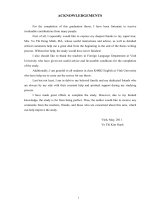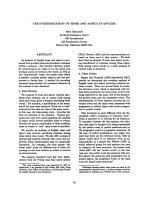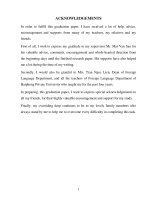Giving orders and instructions in english
Bạn đang xem bản rút gọn của tài liệu. Xem và tải ngay bản đầy đủ của tài liệu tại đây (15.25 KB, 1 trang )
Giving orders and instructions in English
How can you ask someone to do something for you without sounding rude? Here are some of the ways that you
can use to give orders and instructions.
1. Use the imperative form
We use the imperative form to give orders, warnings and advice:
Be quiet!
Take care!
Listen!
Sit down.
Get me something to drink.
You should soften the imperative form with let’s or please while talking to an adult.
Let’s go now, shall we?
Let’s take a break, shall we?
Please listen to what I’m saying. (More polite than ‘Listen to what I am saying.’)
2. Use a modal verb to turn the order into a request
Modal auxiliary verbs can make orders and instructions sound more polite. For example, ‘Could you help me?’ is
more polite than ‘Help me!’
More examples are given below.
Could you make me some tea?
Could you post this letter?
Could you lend me 50 dollars, please?
Could you bring me that file, please?
Could you pick up the kids from school, please?
Can you come here please?
Can you do something for me?
Can you do this for me?
Can you wait a minute?
Can you give me a lift?
Can you fetch Mary from the airport?
Will you keep quiet please?
Would you wait here until I’m back?
Could is more polite than can. Both can and could are followed by a verb without to.
Could you help me with this? (NOT Could you to help me…?)
Stay on top of your writing! Download our grammar guide from www.englishgrammar.org to stay up-to-date.
Powered by TCPDF (www.tcpdf.org)









